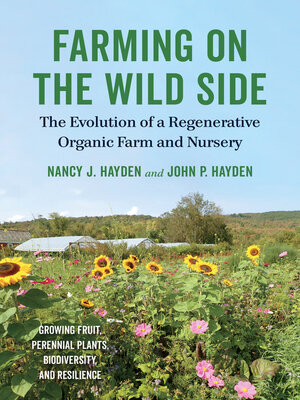Farming on the Wild Side
ebook ∣ The Evolution of a Regenerative Organic Farm and Nursery
By Nancy J. Hayden

Sign up to save your library
With an OverDrive account, you can save your favorite libraries for at-a-glance information about availability. Find out more about OverDrive accounts.
Find this title in Libby, the library reading app by OverDrive.



Search for a digital library with this title
Title found at these libraries:
| Library Name | Distance |
|---|---|
| Loading... |
One farm’s decades-long journey into regenerative agriculture—and how these methods enhance biodiversity, pollinators, and soil health
Northern Vermont’s Nancy and John Hayden have spent the last 25 years transforming their draft horse–powered, organic vegetable and livestock operation into an agroecological, regenerative, biodiverse, organic fruit farm, fruit nursery, and pollinator sanctuary. In Farming on the Wild Side they explain the philosophical and scientific principles that influenced them as they phased out sheep and potatoes and embraced apples, pears, stone fruits, and a wide variety of uncommon berry crops; turned much of their property into a semi-wild state; and adapted their marketing and sales strategies to the new century. As the Haydens pursued their goals of enhancing biodiversity and regenerating their land, they incorporated agroforestry and permaculture principles into perennial fruit polycultures, a pollinator sanctuary, repurposed greenhouses for growing fruit, hügelkultur, and ecological “pest” management. Beyond the practical techniques and tips, this book also inspires readers to develop greater ecological literacy and respect for the mysteries of the global ecosystem. Farming on the Wild Side tells a story about new ways to manage small farms and homesteads, about nurturing land, about ecology, about economics, and about things that we can all do to heal both the land and ourselves.
Northern Vermont’s Nancy and John Hayden have spent the last 25 years transforming their draft horse–powered, organic vegetable and livestock operation into an agroecological, regenerative, biodiverse, organic fruit farm, fruit nursery, and pollinator sanctuary. In Farming on the Wild Side they explain the philosophical and scientific principles that influenced them as they phased out sheep and potatoes and embraced apples, pears, stone fruits, and a wide variety of uncommon berry crops; turned much of their property into a semi-wild state; and adapted their marketing and sales strategies to the new century. As the Haydens pursued their goals of enhancing biodiversity and regenerating their land, they incorporated agroforestry and permaculture principles into perennial fruit polycultures, a pollinator sanctuary, repurposed greenhouses for growing fruit, hügelkultur, and ecological “pest” management. Beyond the practical techniques and tips, this book also inspires readers to develop greater ecological literacy and respect for the mysteries of the global ecosystem. Farming on the Wild Side tells a story about new ways to manage small farms and homesteads, about nurturing land, about ecology, about economics, and about things that we can all do to heal both the land and ourselves.







